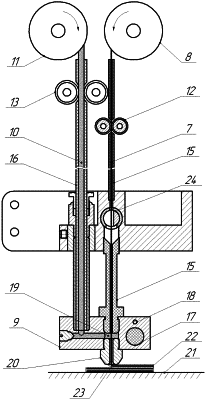| CPC B29C 64/165 (2017.08) [B29C 64/188 (2017.08); B29C 64/209 (2017.08); B29C 64/218 (2017.08); B29C 64/232 (2017.08); B29C 64/236 (2017.08); B29C 64/295 (2017.08); B29C 64/336 (2017.08); B33Y 10/00 (2014.12); B33Y 30/00 (2014.12); B33Y 40/20 (2020.01)] | 18 Claims |

|
1. A method for manufacturing a product from a composite material reinforced with continuous fibers by three-dimensional printing, the method comprising:
feeding a composite fiber in a filamentous form and a thermoplastic material into an extruder, the composite fiber comprising a fiber bundle impregnated with a thermosetting binder with a volume fraction of 15-60% and subjected to temperature treatment until the binder is completely cured;
heating the extruder to a temperature exceeding melting point of the thermoplastic material and glass transition temperature of the thermosetting binder, while the thermoplastic material is combined with the composite fiber;
moving the extruder along a programmed trajectory and extruding the composite material obtained by combining the thermoplastic material with the composite fiber through a nozzle onto a table surface, where the composite fiber becomes rigid upon cooling, and a melt of the thermoplastic material solidifies linking composite fibers together and forming the product; and
in the process of forming the product, executing a cut of the composite fiber by a trimming mechanism, and moving the extruder without extrusion of the composite material to a next section of the programmed trajectory; then resuming extrusion of the composite material,
wherein the composite fibers are laid to produce a ribbed or cellular composite structure for the product, and
wherein when the extruder passes a rib section between intersections, a feed rate to the extruder is set so that a volume content of the composite fibers in the composite material being formed is less than 50% and so that thermoplastics in the composite material being formed is more than 50%; and when the extruder passes an intersection zone, the feed rate of plastic filament decreases and, thereafter, movement stops or begins in an opposite direction to reduce pressure of plastic in a chamber of the extruder chamber to decrease the volume fraction of thermoplastic in the intersection zone to more than 0% and no more than 20%.
|